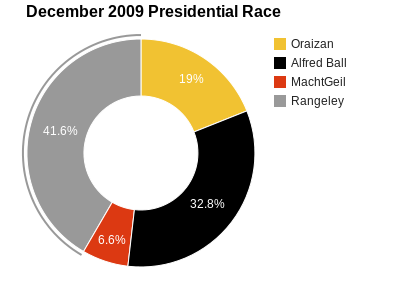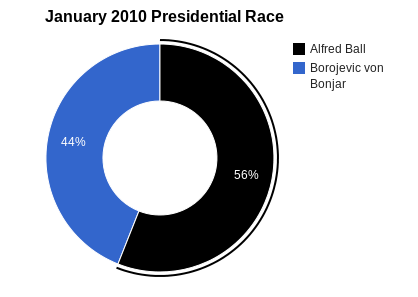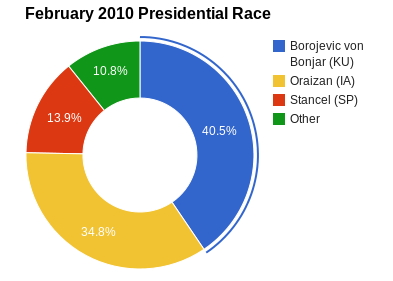[MoE] Political History: The Competitive Era (II)
 •
by
•
by BundesPresseDienst

This is a continuation of a series of articles detailing the political history of eAustria, with this entry beginning in December 2009. This article details the second part of what we are calling the “competitive era” - a time frame with many political battles and swings of influence, as Austria - now in a period of stability - would decide what would come next...
Previous entries:
The One Party Era (April 2009 - August 2009)
The Competitive Era Part I (September 2009 - December 2009)

The Competitive Era (September 2009 - February 2010)
Presidents: Metallon - Rangeley - Rangeley - Rangeley - Alfred Ball - Borojevic von Bonjar
Defining political battles: IA vs RWR, ÖIP vs IA, ÖIP vs NFA
Defining Issue: What type of nation did we want to be?
Defining traits: Big changes in influence - ultimately a strengthened cabinet.
By December, with the changes in the political environment, the coalition of the previous two months was no more. Four candidates ran for president - all four in agreement on foreign policy. Now, other issues would begin to take prominence. The ÖIP again fielded Rangeley, with the RWR’s backing. Wanting to further solidify their mark, the ÖIP aimed for a continuation of the previous months policies and for increased military assistance to allied France.
The NFA backed Minister of Defense Alfred Ball. With more of a military focus, the nationalist NFA aimed for a re-organization of the military after the departure of most of its heavy fighters as members of the IA left for other nations. The IA backed Chief of Staff Oraizan, who found support from the remaining IA members - including Metallon - while the Socialist Party backed its new party president, MachtGeil. The new leadership of the party was much more ideological, and less interested in political coalitions - wanting instead to raise its profile by being more assertive. In this divided field, Rangeley won a third term with 41.61% of the vote.

Changes in December
The December presidential race revealed the internal breakdown of what had formerly been the coalition against the IA, and would show hints of the political battles to come, as the NFA came in a strong second place - their form of nationalism now presenting the biggest competitor to the ÖIP. Though in December itself, tensions would remain low.
Meanwhile, other shifts were still occurring: the cabinet began to slowly grow in influence and power, beyond what had been seen in previous months. Meeting regularly in IRC, this began to create a closer network of players that would provide increasing consistency from month to month.
Another significant change was the growth of the real-life Austrian population. Even as eAustria grew during the summer of 2009, few of the active players were real life Austrians. By late 2009, the number had grown larger, including Vreath in November, and OEBernd in December. The government sought to reach out to Austrian players who might not speak English as well, through German translations of articles - a program undertaken by Minister of Translation Borojevic von Bonjar, himself a real life Austrian.
Borojevic would rise to prominence in his own right during December. Elected leader of the RWR, he reformed it into the Kronloyale Union Party (KU). Unlike the RWR, which had been in decline since September, the KU was an openly conservative party. The change would would be significant, as the KU began to grow.
After three consecutive terms, Rangeley did not run in January 2010. Instead, the NFA again fielded then Minister of Defense Alfred Ball against the newly formed Kronloyale Union’s candidate, Borojevic von Bonjar. The ÖIP would sit out the race officially, as both candidates had close ties to the party, allowing members to vote their conscience. The election saw the NFA come out on top, 56% to 44%.

The National Front of Austria brought a different style to the government. While Alfred Ball would largely continue the foreign policy of the previous government - Rangeley was appointed as Minister of Foreign Affairs - there was a new focus on military organization. With the decline of the IA - which formed the backbone of the army - Austria’s strength on the battlefield had been reduced. It became necessary to find the “next generation” of fighters and commanders, which the government made a focus. Nonetheless, the force continued to be used defensively, mostly helping France against a Spanish invasion.
Economic policy likewise saw a continuation from the previous government, as the ÖIP’s stoneman was maintained as Minister of Finance. But domestic affairs saw a significant change in tone. While the ÖIP-led government was totally averse to any media-warring, the NFA viewed it as a recruiting tool, with the Socialist Party as their target. These disputes were both on policy and of a personal nature, which drew some criticism from the ÖIP and IA for the latter, as being inappropriate actions for the government. The strategy, however, was to some extent successful in boosting party morale and membership.
This began to draw a new dividing line in Austrian politics, which saw the more nationalist NFA on one side, and the more liberal ÖIP on the other. The final election of this era saw this dividing line tested somewhat, with the NFA throwing its support behind the conservative KU and their candidate, Borojevic von Bonjar, in an alliance of the more conservative parties. The ÖIP would back the IA’s candidate, Oraizan - a party alliance unthinkable just a few months earlier. The Socialist Party would run its own candidate however, again seeking to raise its profile, in a move that made the field more divided. Ultimately, with the IA still depleted and the KU on the rise, Borojevic’s KU came out on top (40.51% over Oraizan’s 34.81
😵, with the Socialist Party’s Stancel in third (13.92
😵.

Although not a direct competition between the two parties, the result could be seen as the NFA outboxing the ÖIP for the first time, as they now endorsed opposing candidates. It would be the first setback for the party after its period of success through the latter part of 2009.
Election of Borojevic
The election of Borojevic von Bonjar brought a real-life Austrian to the presidency for the first time, a group which continued to grow. In the previous month, Penegrin (KU), PrinceOfAustria (NFA), and samu-l (NFA) all joined the game. Borojevic would not continue the media war of his predecessor, taking a more moderate tact, and instead his term began relatively calmly - representing the overall strategy of the KU towards conservative realism.
Where the February election might have been read as a success for the NFA, some key members left the party early in the month, including party president Alfred Ball. The NFA was now led by Kaiser Alex. This signalled a decline in the NFA, as it would now be the KU which found itself in the most dominant political role - albeit in one that was still very competitive.
End of an Era
The consensus on foreign policy was stable, even in an environment with other shifts. It is interesting to think how things may have played out, had they the chance. But this era’s end would come not with any internal events; instead it would be swept away with the Croatian invasion of Austria in early February 2010.
Next: The Croatian War Era


Comments
great job
V!
Monumental article!
o7
Soon...
♥ Killer.D ♥
I like... And I am mentioned....
Your beard isn't though - a grave mistake by our resident historian!
Yeah! OEBernd, Vreath, PoA.... the people I know start to be mentioned.... 🙂
What about our international relations? Except France, who where our allies in this period?
After PEACE GC collapsed, we stayed allies with most of its former members, particularly Slovenia, Germany, Hungary, Italy, and France too. Slovenia/Germany/Hungary would found Phoenix, while Italy and France founded Entente, which for the most part got along with Phoenix (at least during this time frame) and cooperated against EDEN. The war was overall a stalemate, but nobody attacked us at all until Croatia (member of EDEN) in February 2010.
V and S
v
Non-Aggression Pacts and their Consequences
Part I: NAPs of Asteria
http://www.erepublik.com/de/article/2496109/1/20
(DE/EN/ES)
Please v+s
Looking forward to the next part: Croatian War. As I can remember it, Austria back then was really close to fall apart. Kind wait to get this moments again refreshed in my head, good job!